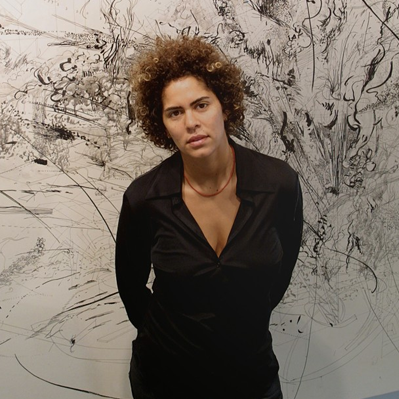
Biography
Julie Mehretu is an American contemporary visual artist, known for her multi-layered paintings of abstracted landscapes on a large scale. Her paintings, drawings, and prints depict the cumulative effects of urban sociopolitical changes.
Mehretu is included in Time magazine's 100 Most Influential People of 2020.
Early life and education
Mehretu was born in Addis Ababa, Ethiopia in 1970, the first child of an Ethiopian college professor of geography and an American Montessori teacher. They fled the country in 1977 to escape political turmoil and moved to East Lansing, Michigan, for her father's teaching position in economic geography at Michigan State University. A graduate of East Lansing High School, Mehretu received a Bachelor of Arts degree from Kalamazoo College in Kalamazoo, Michigan, and did a junior year abroad at Cheikh Anta Diop University (UCAD) in Dakar, Senegal, then attended the Rhode Island School of Design in Providence, Rhode Island, where she earned a Master of Fine Arts degree in 1997. Mehretu shares her studio with her partner, artist Jessica Rankin. Her mother-in-law is author and poet Lily Brett.
Art career
Mehretu's canvases incorporate elements from technical drawings of various urban buildings and linear illustrations of urban efficiency, including city grids and weather charts. The pieces do not contain any formal, consistent sense of depth, instead of utilizing multiple points of view and perspective ratios to construct flattened re-imaginings of city life. Her drawings are similar to her paintings, with many layers forming complex, abstracted images of social interaction on a global scale. The relatively smaller-scale drawings are opportunities for exploration made during the time between paintings.
I think of my abstract mark-making as a type of sign lexicon, signifier, or language for characters that hold identity and have social agency. The characters in my maps plotted, journeyed, evolved, and built civilizations. I charted, analyzed, and mapped their experience and development: their cities, their suburbs, their conflicts, and their wars. The paintings occurred in an intangible no-place: a blank terrain, an abstracted map space. As I continued to work I needed a context for the marks, the characters. By combining many types of architectural plans and drawings I tried to create a metaphoric, tectonic view of structural history. I wanted to bring my drawing into time and place.
Arabic lettering and forms that reference Arabic script scatter around the canvas.[3] In Stadia I, II, and III (2004) Mehretu conveys the cultural importance of the stadium through marks and layers of flat shape. Each Stadia contains an architectural outline of a stadium, abstracted flags of the world, and references to corporate logos.[10] Mogamma: A Painting in Four Parts (2012), the collective name for four monumental canvases that were included in dOCUMENTA (13), relates to 'Al-Mogamma', the name of the all purpose government building in Tahrir Square, Cairo which was both instrumental in the 2011 revolution and architecturally symptomatic of Egypt's post-colonial past. The word 'Mogamma', however, means 'collective' in Arabic and historically, has been used to refer to a place that shares a mosque, a synagogue and a church and is a place of multi faith.[11] A later work, The Round City, Hatshepsut (2013) contains architectural traces of Baghdad, Iraq itself – its title referring to the historical name given to the city in ancient maps. Another painting, Insile (2013) built up from a photo image of Believers' Palace amid civilian buildings, activates its surface with painterly ink gestures, blurring and effacing the ruins beneath.[12]
While best known for large-scale abstract paintings, Mehretu has experimented with prints since graduate school at the Rhode Island School of Design, where she was enrolled in the painting and printmaking program in the mid-1990s. Her exploration of printmaking began with etching. She has completed collaborative projects at professional printmaking studios across America, among them Highpoint Editions in Minneapolis, Crown Point Press in San Francisco, Gemini G.E.L. in Los Angeles, and Derrière L'Etoile Studios and Burnet Editions in New York City.
Mehretu was a resident of the CORE Program, Glassell School of Art, Museum of Fine Arts, Houston (1997–98) and the Artist-in-Residence Program at the Studio Museum in Harlem (2001). During a residency at the Walker Art Center, Minneapolis, in 2003, she worked with thirty high school girls from East Africa. In 2007, she led a monthlong residency program with 40 art students from Detroit public high schools. In the spring of 2007 she was the Guna S. Mundheim Visual Arts Fellow at the American Academy in Berlin.
During her residency in Berlin, Mehretu was commissioned to create seven paintings by the Deutsche Guggenheim; titled Grey Area (2008–2009), the series explores the urban landscape of Berlin as a historical site of generation and destruction. The painting Vanescere (2007), a black-and-white composition that depicts what appears to be a maelstrom of ink and acrylic marks, some of which are sanded away on the surface of the linen support, propelled a layering process of subtraction in the Grey Area series. Parts of Fragment (2008–09) and Middle Grey (2007–09) feature this erasing technique. Another in the series that was painted in Berlin, Berliner Plätze (2008–09), holds a phantom presence of overlapped outlines of nineteenth-century German buildings that float as a translucent mass in the frame. The art historian Sue Scott has this to say of the Grey Area series: "In these somber, simplified tonal paintings, many of which were based on the facades of beautiful nineteenth-century buildings destroyed in World War II, one gets the sense of buildings in the process of disappearing, much like the history of the city she was depicting." As Mehretu explains in Ocula Magazine, 'The whole idea of 20th-century progress and ideas of futurity and modernity have been shattered, in a way. All of this is what is informing how I am trying to think about space.'




































